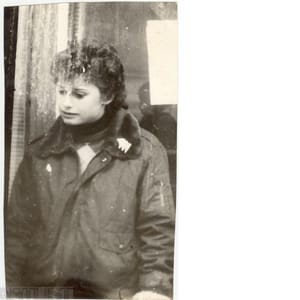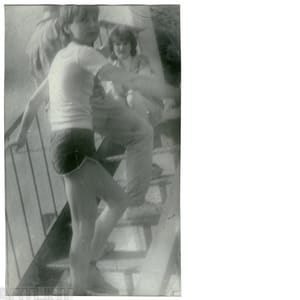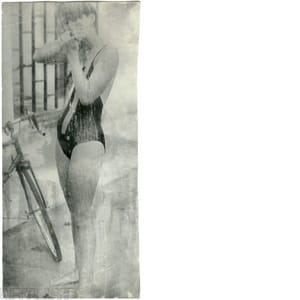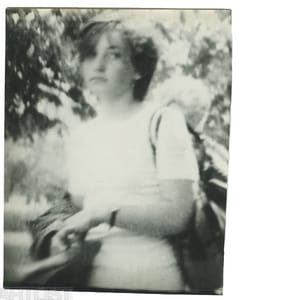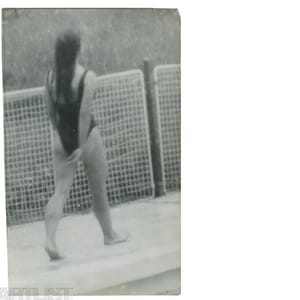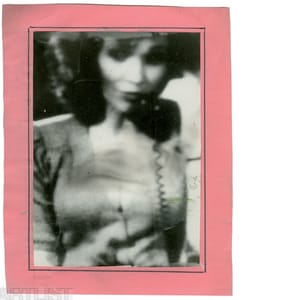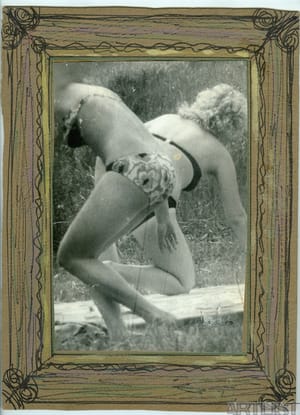- First Name
- Miroslav
- Surname
- Tichý
- Born
- 1926
- Birth place
- Netčice na Moravě
- Place of work
- Kyjov, Hodonín
- Website
- http://tichyfotograf.cz/
- Died
- 2011
- Lived and worked in
- Kyjov (Hodonín)
- Keywords
- CSU Library
- ↳ Find in the catalogue
About artist
Miroslav Tichý's works are among the most highly sought by buyers on the Czech art market, yet art historians and curators do not agree on the value of his art. From the perspective of one side, the promotion of his voyeuristic-tinted works is merely an attempt to make money. The other perspective holds that Tichý is an example of a photographer that created for himself a unique style, independent of the development of the medium, but at the same time corresponding to international trends in contemporary art.
Tichý was absolutely unconcerned about questions regarding the value of his work. He sold part of his work in the 1980s to Czech-Swiss Roman Buxbaum, who was responsible for introducing Tichý's work on the scene. Time will only tell exactly how we end up viewing the artist; meanwhile polemic discussions are being held due to the difficulty in understanding art that is essentially public created from dirty, unattractive photographs made for private pleasure. Tichý can serve as a prime example of how a media-attractive image of an artist can be very quickly made, but his popularity can also indicate that we lack in art something original, wild, existing simply for itself and not for art in the sense of a public, active and engaged discourse.
Miroslav Tichý was born in 1926 in Netčice in Moravia. He lived on and off in Kyjov, Moravia starting in 1930. After the Second World War he studied at the Academy of Fine Arts, which he left in 1948. Upon completing his basic military service, he returned to Kyjov. He was hospitalized at psychiatric treatment centres several times during his life. In the first half of the 1950s he exhibited drawings and paintings along with the Brno avant-garde. From the late 1950s he made less painting and drawing and from the late 1960s began to photograph women, but inconspicuously, without their awareness and consent and for his own pleasure.
Most of his works are from the 1970s and 80s. Tichý gradually gave up on standard social norms and became a figure on the edge of society, living off a disability pension. At the same time he maintained contact with people from the South Moravian culture scene, such as the poet Jiří Veselský. With unique self-built cameras he captured attractive groups of Kyjov women of various ages, most frequently in open public space in everyday situations. The women are photographed in various recreation activities, like riding bikes, running, walking around town, standing in groups or in queues, sitting on benches or sunbathing at a pool (frequently), shopping and even working – in Austrian television night programmes for adults. Using magnifying devices made from his junk at home he created blurred, small-format photographs that went through a chemical process that ended on a small yard in a barrel with rain water. In some photographs he highlighted with a pen the contours of the women's bodies; some he overlaid with paper passe-partout often with a hand-painted frame or ornament imitating South Moravian folklore decoration. Most of the photographs ended up on the floor where they were subjected to time and disregard.
The reaction to Tichý's work and the manner of presenting his work shows that a sensitive area has been touched upon that flusters us in its obscurity. We like things to be clear. There are several focal points in the arguments: Does a work have to be perceived as art by the artist when it is created for us to later accept it as such? How does advertising and promotion of art mesh with serious art theory writing? In other words, are art historians more like promoters interested in profit or unbiased experts? Can a certain photograph be artistic event though it was created outside a developmental framework that took a long time to form? What influences can form the monetary value of an artwork? Is a woman still the object of our insatiable gazes? Why do we like junk? In short, Tichý's photographs provoked a number of questions and reactions in various layers of society. Isn’t this one of the main roles of art?
- Author of the annotation
- Jan Freiberg
CV
Studies:
1945-1948 Academy of Fine Arts Prague, Ján Želibský
Exhibitions
- Solo exhibitions
-
2013
Miroslav Tichý: Fotografické dílo, Galerie Nová síň, Praha
2008
Centre Pompidou, Paris
Museum für moderne Kunst, Frankfurt am Main
2006
Miroslav Tichý, Galerie Šternberk, Šternberk
Miroslav Tichý, Dům umění města Brna, 1. patro, Brno
DeHallen, Frans Hals Museum, Haarlem
2005
Miroslav Tichý, Kunsthaus Zürich, Curych (Zürich)
- Group exhibitions not included in ARTLIST.
-
2013
Aukce výtvarného umění, předaukční výstava, Galerie Nová síň, Praha
2010
Sex extrémně líbezný, Galerie XXL, Louny
2010-2011
The Lucid Evidence: Fotografie aus der Sammlung des MMK, Museum für moderne Kunst, Frankfurt nad Mohanem (Frankfurt am Main)
2010
Prague Photo 2010, Mánes, Praha
2009
Tschechische Fotografie des 20. Jahrhunderts, Kunst- und Ausstellungshalle der Bundesrepublik Deutschland, Bonn
2008
Moderní a poválečné umění, současné umění, fotografie, Galerie 5. patro, Praha
2007
Moderní a poválečné umění. Současné umění. Fotografie, Galerie Louvre, Praha
Kacíř & spol.: Zlaté město / Heretic & Co.: The Golden City, Galerie Jiří Švestka, Biskupský dvůr, Praha
2006
Artists for Tichý - Tichý for Artists, Dům U Jonáše, Pardubice
Artists for Tichý - Tichý for Artists, Uměleckoprůmyslové muzeum, Camera, Brno
2005
Místa paměti, Galerie Šternberk, Šternberk
1997
Desetkrát žena, Galerie Na bidýlku, Brno
Monography
- Articles
Buxbaum, Roman: Ein Außenseiter unter den Außenseitern, Kunstforum 101, 1989, s. 229–231. Buxbaum, Roman: Kunst von Außenseitern – ein Paradigma im Wandel, In: Buxbaum, Roman & Stähli, Pablo: Von einer Wellt zu‘r Andern, Köln, Du Mont 1990, s. 296. Schwabsky, Barry: Miroslav Tichý, Artforum, 2005, č. 10, s. 270. Vančát, Pavel: Miroslav Tichý: Curyšský objev z Moravy, Art & Antiques 4, 2005, č. 10, s. 82–83. Dunděra, Jiří: Miroslav Tichý z Kyjova získal hlavní cenu na fotografickém festivalu v Arles, Kyjovské noviny, 2005, č. 10, říjen, s. 5. Kubišta, Anna: Miroslav Tichý, moravský Diogenes a něžný voyeur, Babylon 15, 2005, č. 2, 31. 10. 2005, s. 4. Kyoichi, Tsuzuki: A Passion Played Out on Photographic Paper, ARTiT 3, 2005, č. 4, Fall/Winter, s. 98–103. Spurný, Jaroslav: Tichý světec z Kyjova, Respekt 16, 2005, č. 52, 27. 12., s. 6. Rizzi, Andrea: Las modelos de Tichý, El Pais semanal, 2005, č. 1523, 4. 12., s. 72–80.
